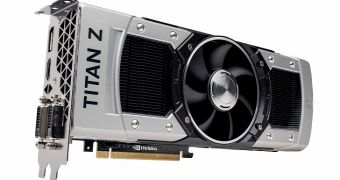All these months we've been trying to find evidence or squeeze promises that NVIDIA will not, in fact, demand three thousand dollars/Euro for the GeForce GTX Titan Z graphics card. We got our wish, but not in the way anyone might have hoped.
Which is to say, the video adapter doesn't cost $3,000 / €3,000, but it doesn't cost less than that either, not on Amazon or eBay.
Instead, its board sells for $3,999 / €3,999, which is, to be blunt, a ludicrously high amount, even for an early listing.
When a retailer jumps the gun, so to speak, they always add a bit on top of the normal price. That amount isn't often $1,000 / €1,000 though.
Nevertheless, if you want to get the adapter within two or three days, that's the kind of cash you need to part with.
There's no question that some gamers will place orders, if they haven't already, simply because they may have run out of patience by this point.
The card was, after all, supposed to come out near the end of April, and now we're approaching the end of May without any official word.
Until last week, it was assumed that NVIDIA had delayed the release of the product in order to give itself a bit more time to refine the driver.
Benchmarks arose, you see, which showed the 12 GB GDDR5, dual-GK110 video adapter being matched by AMD's Radeon R9 295 X2 (8 GB GDDR5, $1,500 / €1,500 price).
Obviously, the odds of the Titan Z selling well in those circumstances weren't very big, which isn't a good thing for a product that isn't expected to sell to more than 1% of the total video adapter market in the first place.
Alas, we've still no confirmation on whether or not the latest GeForce driver gives NVIDIA's card a big enough advantage over AMD's board.
Anyway, the product listed on Amazon is a Zotac Titan Z with 12 GB of GDDR5 VRAM, base clock of 705 MHz for the GPUs, Boost of 876 MHz, and a power rating of 375W. SabreZ is the actual seller though, and stands to make lots of cash if it ensnares buyers.
The traditional shipping cost of $10.49 / €10.49 will bring the price over the four thousand mark, making this possibly the most expensive video card in history, especially after you factor inflation into things. Now if only the price were justified.

 14 DAY TRIAL //
14 DAY TRIAL //